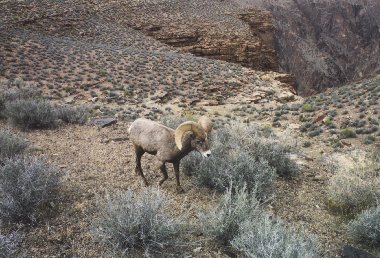| |
Bighorn Sheep
 |
 |
 |
|
|
| Bighorn Sheep are ruminants (even toed,
cud chewing animals). In the last hundred years, their numbers have
declined considerably due to human encroachment and competition with
domestic sheep and wild burros. Bighorns have been reintroduced into
several areas in AZ; however, it remains to be seen whether these populations
have
become self sustaining. |
| |
 |
Natural
History |
 |
|
The desert bighorn is a heavy-bodied, gray-brown, deer-s ized
animal with a large white rump patch. Both males and females have horns, but
the males' are much larger, growing into a curled spiral shape over the course
of several years. A females horns are more narrow and only grow to about 12
inches (half a curl). ized
animal with a large white rump patch. Both males and females have horns, but
the males' are much larger, growing into a curled spiral shape over the course
of several years. A females horns are more narrow and only grow to about 12
inches (half a curl).
|
Can you guess the sex of the bighorn in the photo by looking at its
horns? |
They are found in rugged, rocky desert mountain ranges and some canyons
(the one at right was photographed in the Grand Canyon). They prefer areas with
steep slopes and cliffs where they can be safe from predators. Bighorn sheep
feed with their herds in the early morning, then wait out the heat of the day
by bedding down together in the shade to chew their cuds. The sheep typically
breed during August and September, during which time the males may butt heads
to establish dominance & impress the ewes. Lambs are born in February. |
| |
 |
Diet |
 |
|
| Bighorn are herbivores and eat many
different types of grasses as well as mesquite leaves and beans, desert
lavender, fairy duster, ironwood, palo verde, globemallow, cactus fruits
and agave. During winter months when dew is available and plants contain
more moisture, the sheep can survive for several months without drinking
water. In the heat of the summer when most green plants have dried up,
they seek out cactus fruits for their water content. The sheep have
large stomachs and can drink up to 20% of their body weight in water at
one sitting. This allows them to survive 2-3 days between drinks if they
have to. |
Back to Flora & Fauna |
|

